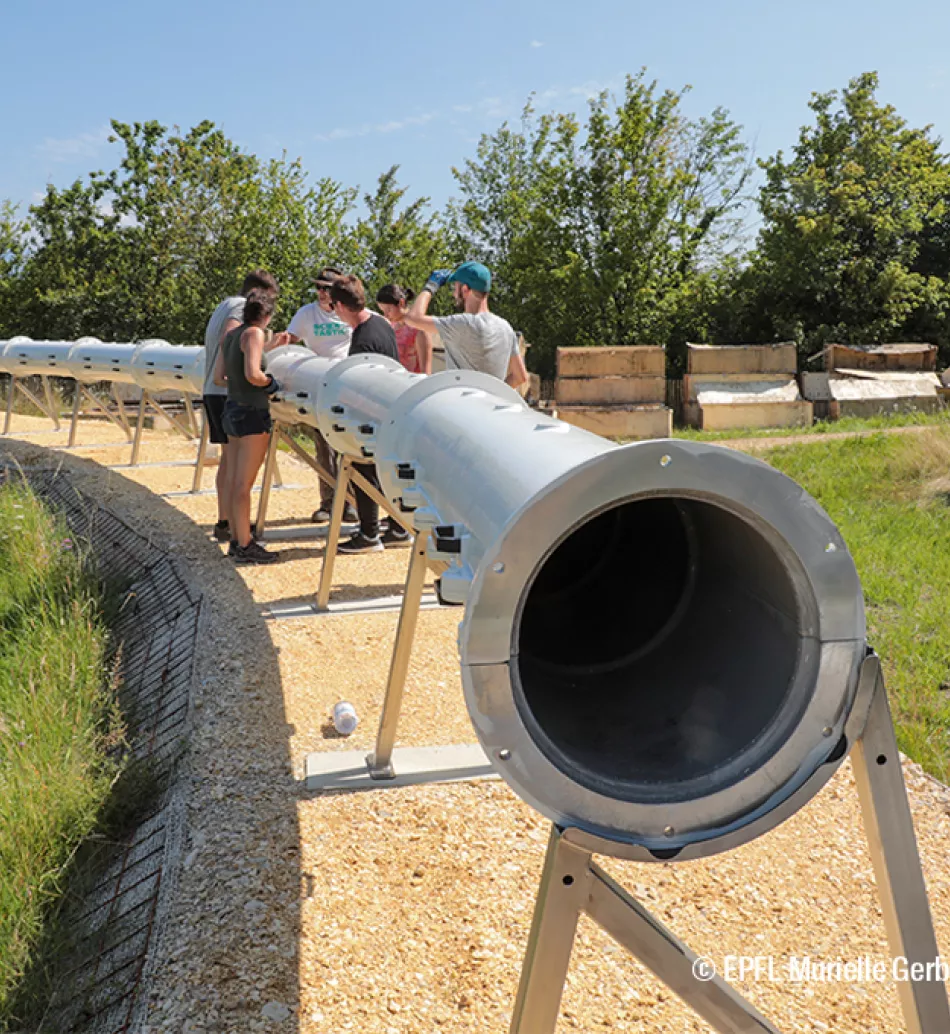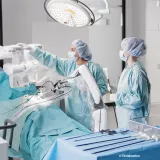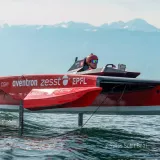When hyperloop meets reality

Test runs are about to start in the Swiss hyperloop tube, a first in Europe. Its circular loop, a world first, will make it possible to measure and optimize the efficiency of “the train of the future” over thousands of kilometres.
A magnetic levitation pod flying up to a speed of 1200km/h in a tube under partial vacuum. This is hyperloop, a public transportation concept which is “greener” than aircraft or even trains, which could bring, in theory, Paris within an hour’s reach from Rome or Los Angeles within thirty minutes from San Francisco.
The idea is not new (the very similar “vactrain” was already imagined in the early 20th century), but it stagnated for a long time. It was not until the release of a white paper in 2013 promoted by Elon Musk, that it became the focus of an extraordinary technological race (see our article in CONNECTED n°11). The billionaire has also stimulated research by organising, from 2016 to 2019, a “hyperloop pod competition” for technical schools around the world. The Swiss Federal Institute of Technology of Lausanne (with LEMO among its partners) also entered competition for the last two editions. Encouraged and supervised by Professor Mario Paolone, responsible for the Distributed Electrical Systems Laboratory (DESL), the EPFLoop team has won several engineering prizes.
Musk’s competition involving a short straight-line acceleration is in no way a proof of feasibility of a real hyperloop. So, Mario Paolone presented a thesis dedicated to the quantified evaluation of a vast array of practical questions. Is it really possible to reach 600-700km/h with an energy-saving solution (condition to ensure the economic viability of hyperloop)? How many shuttles would be necessary to ensure optimal service between two major cities? What capacity? At what frequency? Is it more efficient to let the vacuum system function during off-peak hours? Etc. etc.
By the way, this thesis concluded that hyperloop was an appropriate means of intracontinental transport. Reason enough for the DESL to launch two concrete projects.
The first one is particularly visible: the EPFL has built on campus Europe’s first hyperloop tube! “We want to prove that hyperloop is possible, namely in terms of energy efficiency”, explains André Hodder, one of the “senior” members supporting EPFLoop. “To be able to do this, we need to compare the results of the thesis with reality.”
Test tubes built so far by Virgin HyperloopTT and other players in the field, measure 400m to 4km, too short for studying energy efficiency. “In reality, vehicles will travel for hours over thousands of kilometres. So, we have chosen the only form capable of simulating: a ring.” Designed on a 1:12 scale, this world-first circular hyperloop measures 40m in diameter. Finished in July 2021, civil engineering works have given way to the installation of the tube’s equipment.
Once completed, the ring will be equipped with a multitude of sensors (connected with LEMO solutions) to record the pod’s position as well as a host of other factors. The infrastructure and its use, the low-pressure quality in the tube (how to maintain and repair leaks…), thermal expansion, condensation, failures (and their solutions) will all be evaluated. Along with the best way to communicate with a vehicle moving at high speed in a vacuum-tight tube (necessary for acquiring and transmitting live data).
The tube will obviously also make it possible to test and improve the vehicles themselves. It will be possible to analyse the behaviour of different types of pod, the efficiency of the various engines, the acceleration profiles (bearable for humans) as well as their energy efficiency … All of this, for as long as necessary.
The EPFL will use the results to verify one of its recommended options, which is to power the vehicles with batteries and not through the infrastructure. “Railways are very large electricity consumers, such as a rail-powered hyperloop would be”, adds André Hodder. “By equipping the pods with batteries that we would replace by full batteries – recharged by solar, wind or hydraulic energy - at the end of each trip, the electric networks wouldn’t be impacted.”
The DESL will also use the tube for progressing with its second concrete project, which involves fine-tuning its linear induction motor. This motor was launched in 2019 during the second participation in Elon Musk’s “pod competition”. Accurately named LIMitless (“LIM” for “linear induction motor”), the project was launched together with Professor Mauro Carpita from the HEIG-VD, another Swiss technical school.
The choice of linear induction may sound surprising, since, according to scientific literature, the performance of such an engine is limited to way below the 1000kmph targeted by hyperloop. However, EPFLoop has an idea which could help to bypass these limits. An idea which is promising enough to obtain funding from Innosuisse for a dedicated PhD thesis.
The LIMitless project also benefits from an industrial partner: Swisspod Technologies. This startup was created by Denis Tudor and Cyril Dénéréaz, two former students who were greatly involved with pod competitions and are still members of the EPFLoop.
As indicated by its name, Swisspod works on the development of a vehicle tested on a circuit in the US. Its aim is to validate this type of technology for freight transport. A crucial step, according to Cyril Dénéréaz: “The infrastructure for a hyperloop network will be gigantic. No one will invest billions in technology that hasn’t been tried and tested.”
The history of Hyperloop could follow that of civil aviation. At first, freight transport (think of the adventures of French airmail company Aéropostale!), then, once the technologies and the safety are mature enough, upscaling to embark passengers.
Meanwhile, the EPFL continues to focus on research, mobilising the best brains to solve scientific or technical problems. EPFLoop involves six “senior” members and a dozen students. About a dozen projects gravitate around hyperloop. “There’s a great atmosphere”, says André Hodder. “They are all enthusiasts, with a very positive long-term vision.”
Hodder thinks that there is no time for hesitating. “Energy transition is a must; the situation needs to be urgently improved!” It would take little (soaring oil prices, problems with continental aviation, bottlenecks in the distribution network…) for the situation to swing the situation in favour of hyperloop. The EPFL would then be ready.
Late February, the equipment of the tube was finalised, the first pressure tests were carried out and set up for running. By June, a pod could be launched for the first of many thousands of kilometres.

